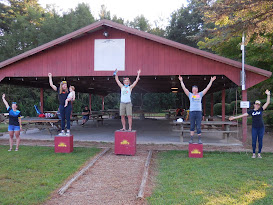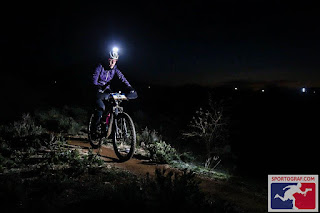A Weekend at Uwharrie: Wood Run MTB race and Kings Mountain Gravel Grinder
Wood Run MTB 36 mile mountain bike race Saturday October 3, 2020
Kings Mountain Gravel Grinder 48 mile race Sunday October 4, 2020
Uwharrie National Forest, Troy, North Carolina
A few days off for vacation time, an interest to learn the trails somewhere new and different, and the urge to race brought the Nankmans to Uwharrie National Forest in North Carolina for a weekend of Trans-Sylvania Productions racing.
Saturday was the Wood Run Mountain Bike race based out of the Wood Run parking area in Uwharrie National Forest. The race had three distance options; 12,24, and 36 miles. Each distance utilized the same 12 mile loop; repeating the loop the appropriate number of times to get the correct distance. The course started with double track, which was perfect to allow the racers spread out a bit. Once hitting single track it was mile after mile of fun and fast riding. The trails at Uwharrie are undulating, twisty, and technical. Speed came easy, and at times the tight turns and loose gravel made for sketchy sections. The climbs were short and steep, leg burning and lung busting especially during a race. A good number of awesome and fun rock gardens are scattered throughout the sections of single track, adding some thought provoking and technical challenges along the way. Mid-race the course passed thought the start/finish and parking area which was a perfect place for racers to leave bottles or to make use of the race supplied aid station. From here it was a short ride on gravel and then back onto the trail to complete the lap. Joël and I each entered the long course, the 36 mile distance. We had very different races, but in the end we both enjoyed the trails and got in great rides. My race was a challenge, possibly even a did-not-finish, right from the get go. A flare-up of a chronic injury made any movement uncomfortable. Wes at Saucon Valley Massage did the best he could to get me race ready but I wasn’t even sure if I could complete the ride. Obviously I did but it was filled with moments of uncertainty and discomfort. Shortly into the race a stick invaded my drive train but luckily Joël was just behind me when this happened. He fixed the twisted chain and bent derailleur but told me something along the lines of “you will have a tough time shifting and your chain may snap at any moment”. The rest of race was filled with sketchy gear changes and wondering if at any moment my pedaling would end. Discomfort from injury and potentially race ending mechanicals…a reason to stop? Nope, a reason to persevere and fight even harder, to be committed to the ride and getting to the finish line. And getting to the finish line fast; winning the women's race. Joël’s race was more of a ride, not a race. Riding a single speed on this type of course he knew right from the start he would not be competitive in the open men division, thus he decided to just ride and make video of the event. Finishing mid pack he was happy with the ride and enjoyed his time out there. Just as an FYI Uwharrie is also a great place to night ride. The night after the mountain bike race (thus the evening before the gravel race) after some wine and whiskey Joel and I decided that taking Cliff out for a night ride seemed like an amazing idea. Maybe not the best advice to do between two hard efforts but to do something fun and interesting it was worth is. Coyotes howling and so many amazing mushrooms (highlighted by the new Lupine Lights Piko 1900) were highlights of the ride.Sunday was the Kings Mountain Gravel Grinder, held at Baldin Lake Recreation Area within Uwharrie National Forest. It was a double loop course, 24 miles per lap, allowing racers to choose from a one lap or two lap event. Joël and I both were riding the 48 miler. The course was a mix of gravel roads, paved roads, and packed dirt roads; no double track or trail. It was a very gentle gravel grinder, perfect for someone just getting into gravel riding or someone who wanted a more relaxing ride. The course wove through beautiful scenery, so many things to look at and enjoy. Throughout the recreation area campers and other park users were out and about enjoying the day. The forest was gorgeous, pine forests, shrubby fields, beautiful blue sky. The course wove through farm land; horses, cattle, and dogs were everywhere. Some adorable donkeys were out in one field. Many farm residents were sitting on their porches, I would assume enjoying coffee and breakfast. They all responded to my wave with a friendly hello.Having a back ground as a road racer, Joël took a look around at the start and said it was going to be like a road race using tactics, drafting, etc. He was in his element. Riding a gravel bike and knowing today would be a day for him to be competitive Joël’s race started hard right from the start. The men's race immediately divided into a lead group of about a dozen who took turns pulling the group while working together to create a buffer between them and other racers. Guys slowly dropped off the back and in the end there were six racers, Joël ending up 6th. He said it was quite the race, quite the hard effort; he was exhausted and happy with his race.
I showed up at the start feeling like a duck out of water. I don’t have a gravel bike. I was riding my full suspension mountain bike, a Liv Pique Advanced. Looking around at the other ladies at the start I wondered how much of a disadvantage I had, what would my ride be like? In fact, in talking to a guy who was also riding a mountain bike I said my only goal was to not be last. Well, I didn’t have to worry about that. I earned the top podium spot of 1st overall woman, showing that you don’t need a gravel bike to win a gravel grinder race. Not knowing at all what to expect, I started conservative. After a few miles I passed other ladies and was in the lead. Well, now that I was in first place I had to keep it. At the turn arounds I could see the second place lady no more than a few minutes behind me which meant I there was no letting up and no taking it easy. I had to work hard, maybe even harder since I had a heavier bike, suspension working against me, and big knobby tires making more resistance. It was tough, I finished the race exhausted and with that previously noted injury bothersome still but so happy to have kept the lead.
Accommodations for the Nankmans for the weekend were the van. National forests are wonderful in that they allowing camping pretty much anywhere, which made for great vanlife living for the weekend. We had an amazing spot directly at Saturday’s race location. We stayed there Friday through Sunday morning, driving over to the gravel race on Sunday morning.Trans-Sylvania Productions did a great job of putting on a well run, smooth, competitive, and fun weekend of racing. Trails were well marked. Courses were challenging, a good ride, and scenic. Post race food was provided in a COVID safe manner. Awards were unique and personal.
Next stop post race? To Saucon Valley Bikes to get the Liv Pique Advanced fixed up. To Honey Stinger to restock on all the race food consumed. Back to Saucon Valley Massage and St. Lukes Spine and Pain to get the body back to working well again.
-
Words by Jess
- Photos by Nankmans and Trans-Sylvania Productionsrace photography




































